译林版四年级上册英语全册教学设计
- 格式:doc
- 大小:4.30 MB
- 文档页数:142
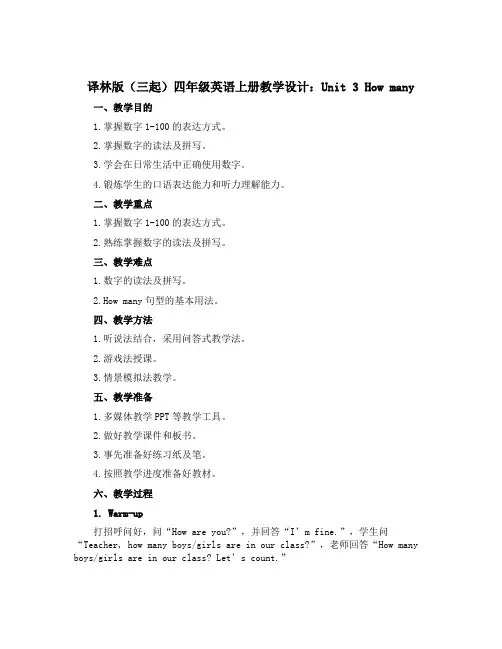
译林版(三起)四年级英语上册教学设计:Unit 3 How many一、教学目的1.掌握数字1-100的表达方式。
2.掌握数字的读法及拼写。
3.学会在日常生活中正确使用数字。
4.锻炼学生的口语表达能力和听力理解能力。
二、教学重点1.掌握数字1-100的表达方式。
2.熟练掌握数字的读法及拼写。
三、教学难点1.数字的读法及拼写。
2.How many句型的基本用法。
四、教学方法1.听说法结合,采用问答式教学法。
2.游戏法授课。
3.情景模拟法教学。
五、教学准备1.多媒体教学PPT等教学工具。
2.做好教学课件和板书。
3.事先准备好练习纸及笔。
4.按照教学进度准备好教材。
六、教学过程1. Warm-up打招呼问好,问“How are you?”,并回答“I’m fine.”,学生问“Teacher, how many boys/girls are in our class?”,老师回答“How many boys/girls are in our class? Let’s count.”2. Presentation1.教师向学生介绍数字1-10的读法及拼写方式。
2.教师出示数字1-10的图片进行教学,附上数字的拼写及读音。
3.教师引导学生模仿口音正确地读和拼写数字。
4.教师再向学生介绍数字11-100的读法及拼写方式。
5.教师出示数字11-100的图片进行教学,附上数字的拼写及读音,并引导学生模仿口音正确地读和拼写数字。
6.教师要求学生口头练习如何用英语表达1-100的数字。
3. Practice1.教师出示问题“How many?”向学生提问。
2.教师进一步引导学生用英语表述自己班上有多少个人。
3.学生根据问题回答,并进行口头练习练习。
4.教师设计数学运算,引导学生进行数字运算练习。
4. Production1.教师出示图片,让学生练习听、说、读日常生活中常用的数字表达方式。
2.学生参考图片进行口语表达,老师逐个点评。
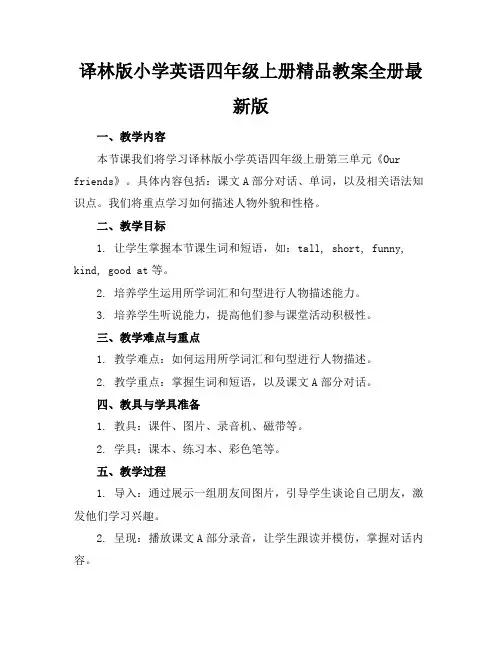
译林版小学英语四年级上册精品教案全册最新版一、教学内容本节课我们将学习译林版小学英语四年级上册第三单元《Our friends》。
具体内容包括:课文A部分对话、单词,以及相关语法知识点。
我们将重点学习如何描述人物外貌和性格。
二、教学目标1. 让学生掌握本节课生词和短语,如:tall, short, funny, kind, good at等。
2. 培养学生运用所学词汇和句型进行人物描述能力。
3. 培养学生听说能力,提高他们参与课堂活动积极性。
三、教学难点与重点1. 教学难点:如何运用所学词汇和句型进行人物描述。
2. 教学重点:掌握生词和短语,以及课文A部分对话。
四、教具与学具准备1. 教具:课件、图片、录音机、磁带等。
2. 学具:课本、练习本、彩色笔等。
五、教学过程1. 导入:通过展示一组朋友间图片,引导学生谈论自己朋友,激发他们学习兴趣。
2. 呈现:播放课文A部分录音,让学生跟读并模仿,掌握对话内容。
3. 讲解:对生词和短语进行讲解,让学生解其含义和用法。
4. 练习:设置小组活动,让学生运用所学词汇和句型进行人物描述,并进行角色扮演。
5. 巩固:进行随堂练习,检查学生对本节课内容掌握情况。
六、板书设计1. 课文A部分对话大意。
2. 生词和短语书写。
3. 人物描述句型。
七、作业设计1. 作业题目:请运用本节课所学词汇和句型,写一段话描述你一个朋友。
答案:My friend is tall and thin. He has black hair and big eyes. He is very funny and kind. He is good at playing basketball.2. 作业题目:翻译下列句子。
答案:(1) 我一个朋友很高大。
(My friend is very tall.)(2) 她头发是金黄色。
(She has blonde hair.)(3) 他很聪明,擅长数学。
(He is smart and good at math.)八、课后反思及拓展延伸1. 课后反思:通过本节课教学,发现部分学生在人物描述时词汇运用不够丰富,需要在今后教学中加强词汇教学。
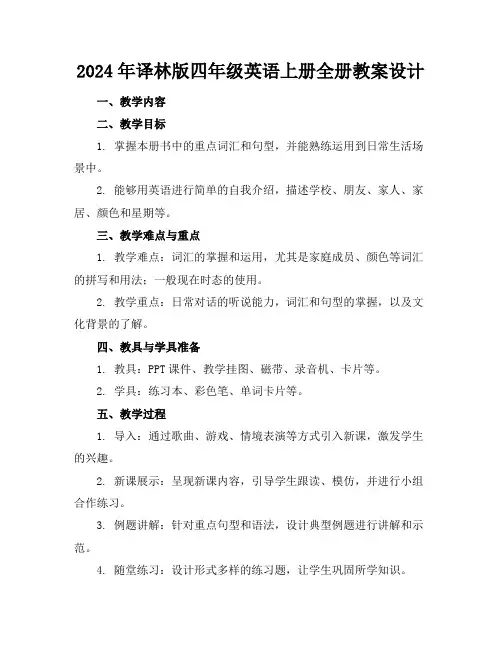
2024年译林版四年级英语上册全册教案设计一、教学内容二、教学目标1. 掌握本册书中的重点词汇和句型,并能熟练运用到日常生活场景中。
2. 能够用英语进行简单的自我介绍,描述学校、朋友、家人、家居、颜色和星期等。
三、教学难点与重点1. 教学难点:词汇的掌握和运用,尤其是家庭成员、颜色等词汇的拼写和用法;一般现在时态的使用。
2. 教学重点:日常对话的听说能力,词汇和句型的掌握,以及文化背景的了解。
四、教具与学具准备1. 教具:PPT课件、教学挂图、磁带、录音机、卡片等。
2. 学具:练习本、彩色笔、单词卡片等。
五、教学过程1. 导入:通过歌曲、游戏、情境表演等方式引入新课,激发学生的兴趣。
2. 新课展示:呈现新课内容,引导学生跟读、模仿,并进行小组合作练习。
3. 例题讲解:针对重点句型和语法,设计典型例题进行讲解和示范。
4. 随堂练习:设计形式多样的练习题,让学生巩固所学知识。
六、板书设计1. 新课和单元主题。
2. 重点词汇和句型。
3. 例题和答案。
4. 课后作业。
七、作业设计1. 作业题目:a.抄写本课重点词汇和句型,每个三遍。
b.根据所给图片,用英语描述学校、朋友、家人、家居、颜色和星期。
c.编写一段自我介绍,介绍自己的学校、朋友和家人。
2. 答案:见附录。
八、课后反思及拓展延伸2. 拓展延伸:鼓励学生课后进行英语阅读、听力训练和口语练习,提高英语实际应用能力。
重点和难点解析一、教学内容的选择与组织重点关注细节:教学内容应紧密围绕教材章节,合理组织,确保学生能够逐步掌握知识。
补充和说明:1. 在教学内容的选择上,应充分考虑到四年级学生的学习水平和认知能力,将教材内容进行适当分解和重组,使其更易于学生理解和接受。
2. 教学内容的组织要遵循由浅入深、循序渐进的原则,确保学生在掌握基础词汇和句型的基础上,逐步提高语言运用能力。
二、教学目标的设定重点关注细节:教学目标应具有可操作性、可检测性,明确具体,以便于教学过程中的实施和评价。
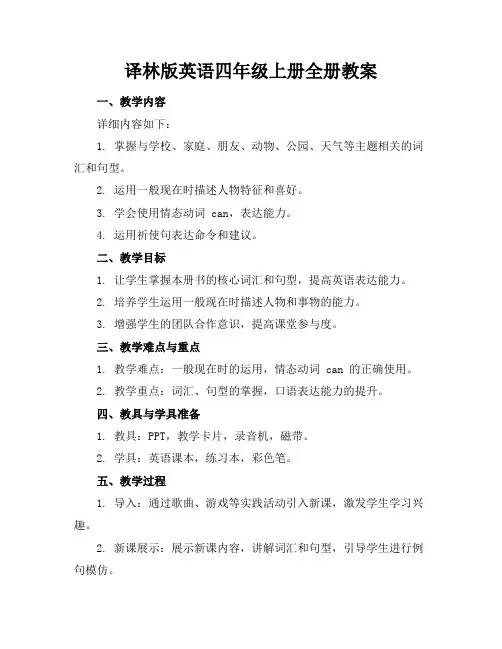
译林版英语四年级上册全册教案一、教学内容详细内容如下:1. 掌握与学校、家庭、朋友、动物、公园、天气等主题相关的词汇和句型。
2. 运用一般现在时描述人物特征和喜好。
3. 学会使用情态动词 can,表达能力。
4. 运用祈使句表达命令和建议。
二、教学目标1. 让学生掌握本册书的核心词汇和句型,提高英语表达能力。
2. 培养学生运用一般现在时描述人物和事物的能力。
3. 增强学生的团队合作意识,提高课堂参与度。
三、教学难点与重点1. 教学难点:一般现在时的运用,情态动词 can 的正确使用。
2. 教学重点:词汇、句型的掌握,口语表达能力的提升。
四、教具与学具准备1. 教具:PPT,教学卡片,录音机,磁带。
2. 学具:英语课本,练习本,彩色笔。
五、教学过程1. 导入:通过歌曲、游戏等实践活动引入新课,激发学生学习兴趣。
2. 新课展示:展示新课内容,讲解词汇和句型,引导学生进行例句模仿。
3. 例题讲解:结合实践情景,讲解一般现在时和情态动词 can 的用法。
4. 随堂练习:设计相关练习题,让学生进行口头和书面练习。
5. 小组活动:分组讨论,运用所学词汇和句型进行角色扮演。
六、板书设计1. 核心词汇和句型。
2. 一般现在时的结构。
3. 情态动词 can 的用法。
七、作业设计1. 作业题目:(1)抄写并翻译 Unit 1Unit 8 的核心词汇和句型。
(2)运用一般现在时,写一篇关于自己家庭成员的短文。
(3)运用情态动词 can,描述自己的能力。
答案:(1)见课本附录。
(2)例文:My family has four members. My father is a teacher. He teaches English. My mother is a doctor. She works in a hospital. My brother is a student. He is in Grade Three.I am a student, too. I like drawing.(3)例文:I can sing and dance. I can play the piano. I can speak English.八、课后反思及拓展延伸1. 反思:关注学生的学习情况,针对难点进行针对性讲解,提高课堂效果。
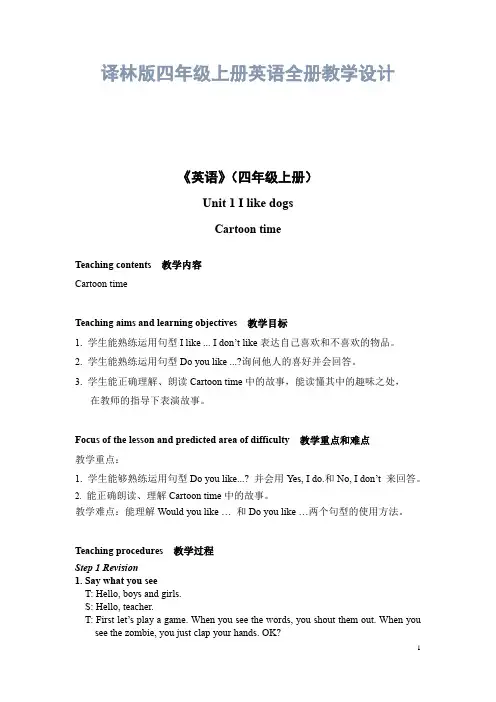
译林版四年级上册英语全册教学设计《英语》(四年级上册)Unit 1 I like dogsCartoon timeTeaching contents 教学内容Cartoon timeTeaching aims and learning objectives 教学目标1. 学生能熟练运用句型I like ... I don’t like表达自己喜欢和不喜欢的物品。
2. 学生能熟练运用句型Do you like ...?询问他人的喜好并会回答。
3. 学生能正确理解、朗读Cartoon time中的故事,能读懂其中的趣味之处,在教师的指导下表演故事。
Focus of the lesson and predicted area of difficulty 教学重点和难点教学重点:1. 学生能够熟练运用句型Do you like...? 并会用Yes, I do.和No, I don’t 来回答。
2.能正确朗读、理解Cartoon time中的故事。
教学难点:能理解Would you like … 和Do you like …两个句型的使用方法。
Teaching procedures 教学过程Step 1 Revision1. Say what you seeT: Hello, boys and girls.S: Hello, teacher.T: First let’s play a game. When you see the words, you shout them out. When you see the zombie, you just clap your hands. OK?S: Ok!T: Great! Let’s begin. (PPT呈现)2. Read the words togetherT: Next, I’ll show you some pictures of the animals. Look, what animal is it?S: It’s cat. /It’s an elephant. /It’s a horse./ It’s dog. / It’s a lion./It’s a monkey.It’s a panda. /It’s a tiger.T: Good. Let’s read them together.3. Spell the wordsShow the toy animals to the students.T: Next, let’s play a game. When the music begins, you pass the toy animal to the next student. When the music stops, you should stop passing. And the student who gets the toy animal should spell the word correctly.(多媒体播放音乐,老师挑选一样动物玩偶让学生在座位上快速传递。
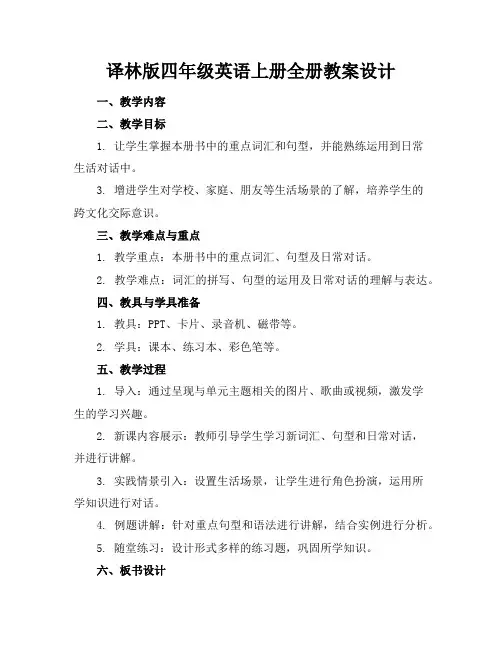
译林版四年级英语上册全册教案设计一、教学内容二、教学目标1. 让学生掌握本册书中的重点词汇和句型,并能熟练运用到日常生活对话中。
3. 增进学生对学校、家庭、朋友等生活场景的了解,培养学生的跨文化交际意识。
三、教学难点与重点1. 教学重点:本册书中的重点词汇、句型及日常对话。
2. 教学难点:词汇的拼写、句型的运用及日常对话的理解与表达。
四、教具与学具准备1. 教具:PPT、卡片、录音机、磁带等。
2. 学具:课本、练习本、彩色笔等。
五、教学过程1. 导入:通过呈现与单元主题相关的图片、歌曲或视频,激发学生的学习兴趣。
2. 新课内容展示:教师引导学生学习新词汇、句型和日常对话,并进行讲解。
3. 实践情景引入:设置生活场景,让学生进行角色扮演,运用所学知识进行对话。
4. 例题讲解:针对重点句型和语法进行讲解,结合实例进行分析。
5. 随堂练习:设计形式多样的练习题,巩固所学知识。
六、板书设计板书设计以直观、简洁为主,突出重点词汇、句型和关键信息。
七、作业设计1. 作业题目:(1)抄写Unit 1Unit 8的重点词汇和句型。
(2)根据所学内容,编写一段关于自己学校、家庭或朋友的日常对话。
(3)完成课后练习题。
2. 答案:教师根据学生完成情况,给予正确答案并进行讲解。
八、课后反思及拓展延伸2. 学生拓展延伸:鼓励学生课后多进行英语阅读、听力训练和口语练习,提高英语实际运用能力。
同时,开展与课程内容相关的实践活动,如参观学校、制作手抄报等,增强学生的学习兴趣和实际操作能力。
重点和难点解析1. 教学内容的选择与组织2. 教学目标的制定3. 教学难点与重点的区分4. 教学过程的设计与实践5. 板书设计的有效性6. 作业设计的针对性与拓展性一、教学内容的选择与组织教学内容应紧密围绕教材,结合学生的实际水平和生活经验,合理安排教学顺序和重点。
每个单元的教学内容应包含词汇、句型、日常对话和文化背景的全面教学。
教师需对教材内容进行深入分析,提炼出核心知识点,并通过丰富多样的教学活动进行有效传递。
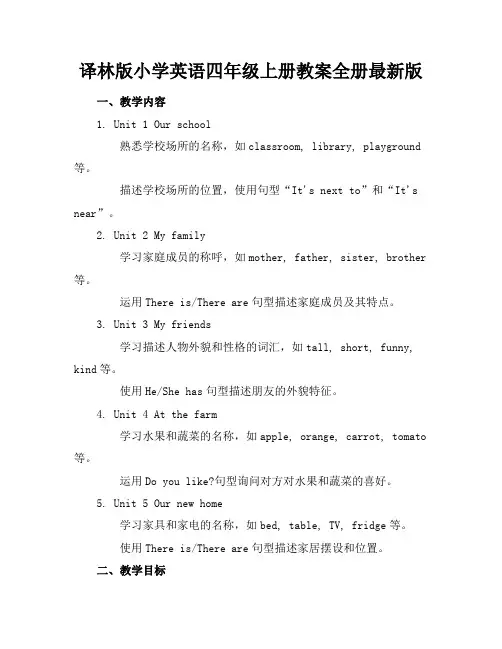
译林版小学英语四年级上册教案全册最新版一、教学内容1. Unit 1 Our school熟悉学校场所的名称,如classroom, library, playground 等。
描述学校场所的位置,使用句型“It's next to”和“It's near”。
2. Unit 2 My family学习家庭成员的称呼,如mother, father, sister, brother 等。
运用There is/There are句型描述家庭成员及其特点。
3. Unit 3 My friends学习描述人物外貌和性格的词汇,如tall, short, funny, kind等。
使用He/She has句型描述朋友的外貌特征。
4. Unit 4 At the farm学习水果和蔬菜的名称,如apple, orange, carrot, tomato 等。
运用Do you like?句型询问对方对水果和蔬菜的喜好。
5. Unit 5 Our new home学习家具和家电的名称,如bed, table, TV, fridge等。
使用There is/There are句型描述家居摆设和位置。
二、教学目标1. 让学生掌握本册书中的词汇和句型,并能熟练运用。
2. 提高学生的听说能力,能就所学话题进行简单的交流。
3. 培养学生的阅读兴趣,提高阅读理解能力。
三、教学难点与重点1. 教学难点:各个单元的重点词汇和句型。
描述人物、事物和场景的语言表达。
2. 教学重点:掌握词汇和句型的用法。
运用所学知识进行实际场景的交流。
四、教具与学具准备1. 教具:教学PPT单词卡片情景图2. 学具:课本练习册彩色笔五、教学过程1. 导入:利用图片、歌曲或小故事引入话题,激发学生兴趣。
让学生预测本课内容,为新课学习做好铺垫。
2. 新课展示:呈现新词汇和句型,引导学生跟读、模仿。
通过例句和情景对话,让学生理解并掌握新知识。
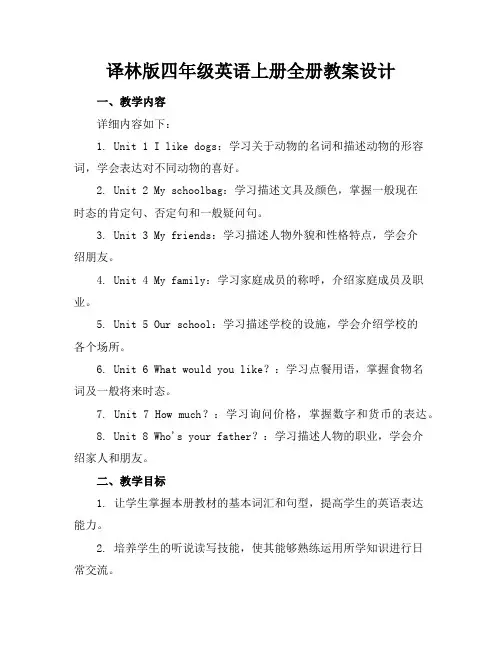
译林版四年级英语上册全册教案设计一、教学内容详细内容如下:1. Unit 1 I like dogs:学习关于动物的名词和描述动物的形容词,学会表达对不同动物的喜好。
2. Unit 2 My schoolbag:学习描述文具及颜色,掌握一般现在时态的肯定句、否定句和一般疑问句。
3. Unit 3 My friends:学习描述人物外貌和性格特点,学会介绍朋友。
4. Unit 4 My family:学习家庭成员的称呼,介绍家庭成员及职业。
5. Unit 5 Our school:学习描述学校的设施,学会介绍学校的各个场所。
6. Unit 6 What would you like?:学习点餐用语,掌握食物名词及一般将来时态。
7. Unit 7 How much?:学习询问价格,掌握数字和货币的表达。
8. Unit 8 Who's your father?:学习描述人物的职业,学会介绍家人和朋友。
二、教学目标1. 让学生掌握本册教材的基本词汇和句型,提高学生的英语表达能力。
2. 培养学生的听说读写技能,使其能够熟练运用所学知识进行日常交流。
三、教学难点与重点1. 教学难点:一般现在时态、一般将来时态、一般疑问句的构成及回答。
2. 教学重点:基本词汇、句型的掌握,日常交流能力的培养。
四、教具与学具准备1. 教具:PPT、录音机、卡片、挂图等。
2. 学具:课本、练习册、笔、纸等。
五、教学过程1. 导入:通过实践情景引入,让学生在轻松愉快的氛围中学习英语。
2. 新课内容:讲解新单词、句型,让学生跟读、模仿,并进行例题讲解。
3. 随堂练习:设计丰富的课堂活动,让学生在练习中巩固所学知识。
六、板书设计1. 板书内容包括:本节课的重点词汇、句型、语法点。
2. 板书设计要求简洁明了,突出重点。
七、作业设计1. 作业题目:(1)抄写本节课的新单词,每个单词写5遍。
(2)用一般现在时态和一般疑问句造句。
(3)根据所学内容,编写一段对话。
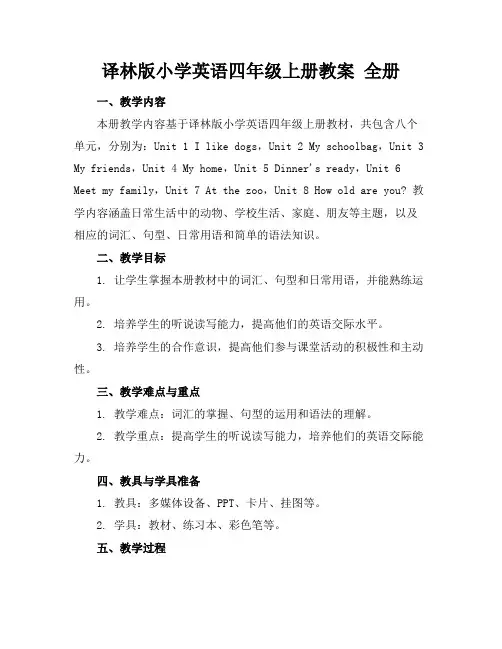
译林版小学英语四年级上册教案全册一、教学内容本册教学内容基于译林版小学英语四年级上册教材,共包含八个单元,分别为:Unit 1 I like dogs,Unit 2 My schoolbag,Unit 3 My friends,Unit 4 My home,Unit 5 Dinner's ready,Unit 6 Meet my family,Unit 7 At the zoo,Unit 8 How old are you? 教学内容涵盖日常生活中的动物、学校生活、家庭、朋友等主题,以及相应的词汇、句型、日常用语和简单的语法知识。
二、教学目标1. 让学生掌握本册教材中的词汇、句型和日常用语,并能熟练运用。
2. 培养学生的听说读写能力,提高他们的英语交际水平。
3. 培养学生的合作意识,提高他们参与课堂活动的积极性和主动性。
三、教学难点与重点1. 教学难点:词汇的掌握、句型的运用和语法的理解。
2. 教学重点:提高学生的听说读写能力,培养他们的英语交际能力。
四、教具与学具准备1. 教具:多媒体设备、PPT、卡片、挂图等。
2. 学具:教材、练习本、彩色笔等。
五、教学过程1. 导入:通过歌曲、游戏、情景剧等方式,激发学生的学习兴趣,引入新课。
2. 呈现:展示新课内容,讲解词汇、句型和语法,并进行例句展示。
3. 实践:进行角色扮演、小组讨论、随堂练习等活动,让学生在实际语境中运用所学知识。
4. 巩固:通过游戏、竞赛、复述等方式,帮助学生巩固所学内容。
六、板书设计板书内容应包括:课题、重点词汇、句型、语法和拓展内容。
设计要简洁明了,突出重点。
七、作业设计1. 作业题目:(1)抄写本节课所学的词汇和句型。
(2)根据所学内容,编写一段对话。
(3)完成练习册的相关练习。
2. 答案:见课后附件。
八、课后反思及拓展延伸2. 拓展延伸:推荐学生观看英语动画片、阅读英语绘本等,提高他们的英语学习兴趣,拓宽知识面。
重点和难点解析1. 教学过程的实践情景引入2. 教学难点的突破方法3. 作业设计的针对性和拓展延伸的实用性详细补充和说明:一、教学过程的实践情景引入1. 结合生活实际:根据教学内容,设计贴近学生生活的情景,让学生在熟悉的语境中感知、理解和运用英语。
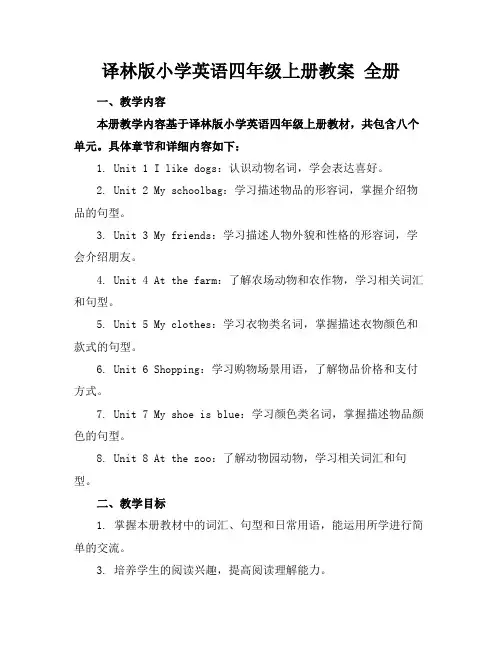
译林版小学英语四年级上册教案全册一、教学内容本册教学内容基于译林版小学英语四年级上册教材,共包含八个单元。
具体章节和详细内容如下:1. Unit 1 I like dogs:认识动物名词,学会表达喜好。
2. Unit 2 My schoolbag:学习描述物品的形容词,掌握介绍物品的句型。
3. Unit 3 My friends:学习描述人物外貌和性格的形容词,学会介绍朋友。
4. Unit 4 At the farm:了解农场动物和农作物,学习相关词汇和句型。
5. Unit 5 My clothes:学习衣物类名词,掌握描述衣物颜色和款式的句型。
6. Unit 6 Shopping:学习购物场景用语,了解物品价格和支付方式。
7. Unit 7 My shoe is blue:学习颜色类名词,掌握描述物品颜色的句型。
8. Unit 8 At the zoo:了解动物园动物,学习相关词汇和句型。
二、教学目标1. 掌握本册教材中的词汇、句型和日常用语,能运用所学进行简单的交流。
3. 培养学生的阅读兴趣,提高阅读理解能力。
三、教学难点与重点1. 教学难点:词汇的拼写和句型的运用。
2. 教学重点:日常用语的掌握和口语交流能力的培养。
四、教具与学具准备1. 教具:教材、PPT、卡片、录音机等。
2. 学具:课本、练习册、文具等。
五、教学过程1. 导入:通过图片、歌曲或小故事引入新课,激发学生兴趣。
2. 呈现:展示新课内容,讲解词汇和句型,进行例句演示。
3. 实践:组织学生进行角色扮演、小组讨论等实践活动,巩固所学。
4. 练习:进行随堂练习,检查学生对词汇和句型的掌握情况。
6. 作业布置:布置课后作业,要求学生复习巩固。
六、板书设计1. Unit 1 I like dogs2. 词汇:dog, cat, fish, bird, elephant等3. 句型:I like , Do you like ?4. 例句:I like dogs. They're cute.七、作业设计1. 作业题目:(1)抄写本节课所学的词汇和句型。
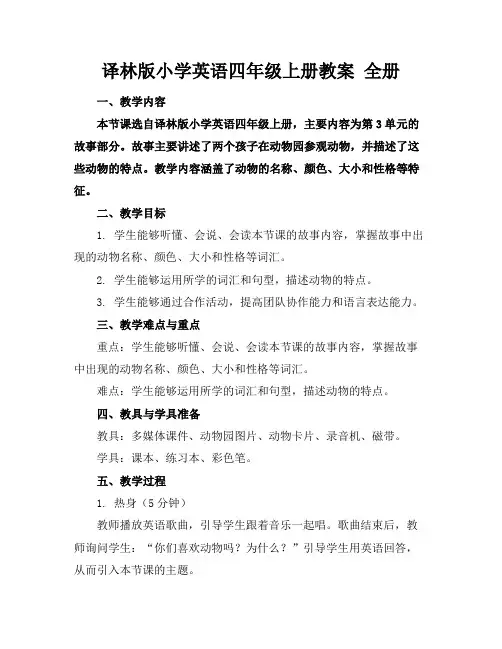
译林版小学英语四年级上册教案全册一、教学内容本节课选自译林版小学英语四年级上册,主要内容为第3单元的故事部分。
故事主要讲述了两个孩子在动物园参观动物,并描述了这些动物的特点。
教学内容涵盖了动物的名称、颜色、大小和性格等特征。
二、教学目标1. 学生能够听懂、会说、会读本节课的故事内容,掌握故事中出现的动物名称、颜色、大小和性格等词汇。
2. 学生能够运用所学的词汇和句型,描述动物的特点。
3. 学生能够通过合作活动,提高团队协作能力和语言表达能力。
三、教学难点与重点重点:学生能够听懂、会说、会读本节课的故事内容,掌握故事中出现的动物名称、颜色、大小和性格等词汇。
难点:学生能够运用所学的词汇和句型,描述动物的特点。
四、教具与学具准备教具:多媒体课件、动物园图片、动物卡片、录音机、磁带。
学具:课本、练习本、彩色笔。
五、教学过程1. 热身(5分钟)教师播放英语歌曲,引导学生跟着音乐一起唱。
歌曲结束后,教师询问学生:“你们喜欢动物吗?为什么?”引导学生用英语回答,从而引入本节课的主题。
2. 引入(10分钟)教师出示动物园的图片,引导学生说出他们认识的动物。
然后,教师展示本节课的故事内容,让学生初步了解故事情节。
3. 讲解(15分钟)教师逐句讲解故事内容,让学生跟读。
同时,教师教授故事中出现的动物名称、颜色、大小和性格等词汇,让学生口头练习。
4. 练习(10分钟)教师分角色让学生扮演故事中的角色,进行情景对话。
学生通过角色扮演,运用所学的词汇和句型,描述动物的特点。
5. 巩固(10分钟)教师发放动物卡片,让学生两两一组,用英语进行动物特点的描述。
然后,教师邀请几组学生上台展示,大家共同评价。
6. 拓展(5分钟)教师引导学生思考:“你们还知道哪些动物的特点?请用英语说出来。
”学生自由发言,大家共同学习。
六、板书设计本节课的板书设计如下:动物名称颜色大小性格熊猫 black small cute老虎 yellow big brave猴子 white medium naughty七、作业设计1. 完成练习册第3单元的相关练习。
义务教育教科书(江苏)四年级英语上册教案 Unit 1 I like dogs 第一教时教学内容:Story time1. 能听懂、会说、会读、会写词汇:like, dog, cat, panda, horse, tiger.2. 能听懂、会说、会读、会写句型与日常用语:I like . . . I don’t like . . . Do you like . . . ?Yes, I do. / No, I don’t.3. 能听懂、会说、会读词汇:animal, cute, fat, elephant, lion, monkey.4. 能听懂、会说、会读句型:Look at these toy animals. Look at this cat. It’s cute. They’re cute and fat.5. 通过学习能初步用英语介绍自己喜欢或不喜欢的动物。
教学重点:句型:I like . . . I don’t like . . . Do you like . . . ?及其回答Yes, I do. / No, I don’t.词汇:like, dog, cat, panda, horse, tiger,do.教学难点:句型:I like . . . I don’t like . . . Do you like . . . ?及其回答Yes, I do. / No, I don’t.的语调和用法词汇:animal, monkey, elephant, horse等词的读音。
教学准备:1. Story time部分出现的动物图片或玩具(尤其是逗人可爱的玩具)2. 多媒体,教学光盘,录音磁带。
教学过程:A. Warming up1. Greetings2. Sing a songOn the farm(三年级英语下册)Pigs on the farm go “ oink, oink”Cows on the farm go “ moo, moo”Ducks on the farm go “ quack, quack”T: What’s on the farm?Ss: Cows, pigs and ducks.T: Yes. Cows, pigs and ducks are animals.板书并领读:animalT: Do you like animals?S: Yes, I do.B. Presentation and practice1. 教师出示一只逗人喜爱的玩具狗。
译林版英语四年级上册全册教案一、教学内容本节课为人教版英语四年级上册Unit 2 Let's play cricket!部分。
本节课主要让学生掌握一般现在时态的肯定句和否定句,以及一般现在时态的疑问句。
同时,学生能够运用所学知识进行简单的日常交流。
二、教学目标1. 学生能够听懂、会说、会读一般现在时态的肯定句、否定句和疑问句。
2. 学生能够运用一般现在时态进行简单的日常交流。
3. 学生能够通过合作学习,提高自己的团队协作能力。
三、教学难点与重点重点:一般现在时态的肯定句、否定句和疑问句的构成及运用。
难点:一般现在时态的疑问句的构成及运用。
四、教具与学具准备教具:PPT、黑板、粉笔、挂图学具:课本、练习本、文具五、教学过程1. 热身(5分钟)教师与学生进行简单的英语对话,营造轻松愉快的英语学习氛围。
然后,引导学生回顾上一节课所学内容,为新课的学习做好铺垫。
2. 引入(10分钟)教师通过挂图或PPT展示一般现在时态的肯定句、否定句和疑问句的例子,引导学生观察并思考:“These sentences are inpresent si mple tense. Can you guess what they mean?”学生思考后,教师揭晓答案,并简要讲解一般现在时态的构成及用法。
3. 呈现(10分钟)教师通过PPT或黑板,呈现本节课的一般现在时态的肯定句、否定句和疑问句的例子,引导学生跟读并模仿。
教师适时给予表扬和鼓励,增强学生的学习信心。
4. 操练(10分钟)教师组织学生进行小组活动,让学生相互练习一般现在时态的肯定句、否定句和疑问句。
教师巡回指导,纠正学生的发音和语法错误。
5. 巩固(10分钟)教师通过PPT或黑板,展示一些一般现在时态的肯定句、否定句和疑问句的练习题,让学生独立完成。
教师及时批改并给予反馈,提高学生的答题能力。
6. 拓展(5分钟)教师引导学生运用一般现在时态进行角色扮演,模拟日常生活中的场景。
Unit1 I like dogs第(1 )课时教学目标:能初步听懂、会读、会拼写单词cat, dog,elephant,horse,lion,monkey, panda,tiger2.能听懂、会说、会读、会运用句型Do you like…?并且会用Yes, I do.和No,I don’t 来回答。
3.情感教育:动物是人类的好朋友,要保护动物教学重点:1.能初步听懂、会读、会拼写单词cat, dog,elephant,horse,lion,monkey, panda,tiger2.能听懂、会说、会读、会运用句型Do you like…?并且会用Yes, I do.和No,I don’t 来回答。
教学难点:1.能初步听懂、会读、会拼写单词cat, dog,elephant,horse,lion,monkey, panda,tiger2.能听懂、会说、会读、会运用句型Do you like…?并且会用Yes, I do.和No,I don’t 来回答。
3.能明白并理解名词的复数形式,理解like的后面用可数名词的复数形式教学准备:挂图,卡片,多媒体(PPT)教学过程:Step 1 Warm upGreetingOrder game: Stand up,boys and girls.Open your books, boys.Free talk小诗:Five little monkeys歌曲:Seasons song.Step 2 Presentation1.Play a game----根据老师说的例句或者词组,举一反三出示课题:Unit 1 I like dogsT:Today,let’s learn Unit 1 I like dogs.T: I like dogs .Do you like dogs?S: Yes, I do./No, I don’t.T: What do you like?S: I like …出示句型:Do you like…?Yes, I do.No, I don’t.I like…根据学生的回答教授单词:cat ,dog, monkey, lion, panda, tiger, bear。
译林版四年级英语上册全册教案一、教学内容1.<Unit 1 I like dogs>:介绍动物名词,学会表达喜好;2.<Unit 2 My schoolbag>:学习文具名词,掌握There be句型;3. <Unit 3 My friends>:学习描述人物特征,运用形容词;4. <Unit 4 At the farm>:学习蔬菜和水果名词,掌握一般疑问句;5. <Unit 5 Our new home>:学习房间和家具名词,运用介词;6. <Unit 6 In the kitchen>:学习厨房用品名词,掌握祈使句;7. <Unit 7 Days of the week>:学习星期名词,运用一般现在时;8. <Unit 8 How are you?>:学习身体部位名词,掌握特殊疑问句。
二、教学目标1. 让学生掌握基本的词汇和句型,提高英语表达能力;2. 培养学生运用英语进行日常交流的能力;3. 培养学生合作学习、自主学习的能力。
三、教学难点与重点1. 教学难点:词汇的准确运用,句型的正确使用;2. 教学重点:培养学生口语表达能力,提高英语学习兴趣。
四、教具与学具准备1. 教具:PPT、图片、卡片、录音机等;2. 学具:课本、练习册、彩笔、剪刀等。
五、教学过程1. 导入:通过歌曲、游戏、故事等引入新课,激发学生兴趣;2. 呈现:展示PPT,讲解新词汇和句型,让学生跟读;3. 实践:设置实践情景,让学生进行角色扮演,运用所学知识;4. 练习:进行随堂练习,巩固所学知识;6. 布置作业:布置课后作业,让学生复习巩固。
六、板书设计1. 新词汇和句型;2. 重点语法和表达方式;3. 课堂练习和作业。
七、作业设计1. 作业题目:(1)抄写新学的词汇和句型;(2)根据所学内容编写一段对话;(3)完成课后练习题。
译林版四年级英语上册全册教案优化后的教学内容呈现:一、教学内容本课为四年级英语上册第三单元的第一课时,核心内容涉及对不同动物的单词学习及运用句型“What's this? It's a/an What are these? They are”进行互动。
涉及的动物单词包括:cat, dog, fish, bird, mouse, cow, horse, tiger, lion, panda。
二、教学目标1. 学生能准确认读和拼写动物单词。
2. 学生能在适当的情境中,运用所学句型进行问答。
3. 学生能理解并听懂关于动物的简单对话。
三、教学重难点重点:掌握并正确使用单元核心单词。
难点:灵活运用句型进行物品询问。
四、教学工具与材料教学工具:单词卡片、动物图片、录音设备。
学习材料:练习本、学习软件。
五、教学过程1. 课前热身(5分钟):播放英语歌曲,引导学生唱跳,进行简单的语言互动,如问候和日常对话。
2. 课堂导入(10分钟):通过展示一张动物图片,引导学生猜测,并用英文表述。
随后,依次展示其他动物图片,巩固单词学习。
3. 单词与句型学习(15分钟):利用单词卡片,逐一教授单词,强调发音和拼写。
通过例句和角色扮演,让学生实践句型。
4. 互动练习(10分钟):学生分组,用所学单词和句型进行角色扮演,模拟真实场景。
5. 听力训练(5分钟):播放包含单元单词的对话或故事,学生跟随录音进行听力练习。
六、板书设计板书将包含动物单词列表和句型结构,以直观的方式展现关键信息。
七、作业设计1. 单词抄写:每个单词五遍。
2. 情景对话:编写一个关于动物的小对话,运用新学的句型。
3. 听力作业:听录音,跟读单词和句型。
八、教学反思与拓展教师需反思教学方法的有效性,并根据学生的反应调整教学策略。
拓展活动可以是让学生绘制他们最喜欢的动物,并写一段话描述它,增强学生的创造力和语言运用能力。
译林版小学四年级英语上册教案教学是一种创造性劳动。
写一份优秀教案是设计者教育思想、智慧、动机、经验、个性和教学艺术性的综合体现。
一起看看译林版小学四年级英语上册教案!欢迎查阅!译林版小学四年级英语上册教案11.教学目标:1) Students can use the four skilled words “monkey”, “bear”, “panda”. Students can understand the three skilled words “giraffe”, “cancel”.2) Students can master the sentence “What’s this in English?” .3) Train the students to love the animals, love the world.2.教学重点:1)The four skilled words: “monkey”, “bear”, “panda”.2)The three skilled words: “giraffe”, “cancel”.3.教学难点:Using the sentence to make up their own dialogues.4.教学过程:Step1: warmingPlay a guessing game.Teacher shows the pictures. Students guess “What’s this in English?”Six students in one group. If their answer is right, they will get two points for their group.Step 2: presentationUsing the game to teach the new words “monkey”, “bear”, “panda”, “giraffe”, “cancel”Students spell the words one by one.Step 3: look and sayStudents open their books and read the dialogue after the tape.Six students in one group practice the dialogue.Invite several groups to act out the dialogue.Which group done a good job, they can get 10 points.Step 4: practiceStudents use the pictures to make up their own dialogues.Do a surveyEach student has a table. Be a reporter and interview your friends.--What would you like?--Would you like…?Step 5: summarySummarize what we have learned today.5.作业设计:1)Read and recite the dialogue.2)Finish off the exercisebook.译林版小学四年级英语上册教案2教材分析及设计理念:本课围绕购物展开教学,主要学习四个名词sunglasses, gloves, umbrella, scarf。
译林版四年级上册英语全册教学设计《英语》(四年级上册)Unit 1 I like dogsCartoon timeTeaching contents 教学内容Cartoon timeTeaching aims and learning objectives 教学目标1. 学生能熟练运用句型I like ... I don’t like表达自己喜欢和不喜欢的物品。
2. 学生能熟练运用句型Do you like ...?询问他人的喜好并会回答。
3. 学生能正确理解、朗读Cartoon time中的故事,能读懂其中的趣味之处,在教师的指导下表演故事。
Focus of the lesson and predicted area of difficulty 教学重点和难点教学重点:1. 学生能够熟练运用句型Do you like...? 并会用Yes, I do.和No, I don’t 来回答。
2.能正确朗读、理解Cartoon time中的故事。
教学难点:能理解Would you like … 和Do you like …两个句型的使用方法。
Teaching procedures 教学过程Step 1 Revision1. Say what you seeT: Hello, boys and girls.S: Hello, teacher.T: First let’s play a game. When you see the words, you shout them out. When you see the zombie, you just clap your hands. OK?S: Ok!T: Great! Let’s begin. (P PT呈现)2. Read the words togetherT: Next, I’ll show you some pictures of the animals. Look, what animal is it?S: It’s cat. /It’s an elephant. /It’s a horse./ It’s dog. / It’s a lion./It’s a monkey.It’s a panda. /It’s a tiger.T: Good. Let’s read th em together.3. Spell the wordsShow the toy animals to the students.T: Next, let’s play a game. When the music begins, you pass the toy animal to the next student. When the music stops, you should stop passing. And the student who gets the toy animal should spell the word correctly.(多媒体播放音乐,老师挑选一样动物玩偶让学生在座位上快速传递。
音乐停,手拿动物玩偶的同学必须正确拼读出该种动物的英文单词。
然后,老师换另一个动物玩偶,学生们继续传递。
)Step 2 Summary1. Play a game(全班同学分成四大组,每一组同学依次说出自己喜欢的动物: I like .... 老师说出一种动物,看看其他同学是否还记得是谁喜欢这种动物。
用Do you like ...?来询问这位同学,如果得到的回答是:Yes, I do. 则表示这位猜的同学答对了!) T: Who likes dogs? Do you remember? (The students in the other groups guess.)S1: xxxT: You can go and ask him: Do you like ...?S1: Do you like dogs?S2: Yes, I do.T: Well done! You have a good memory!2. Grammar timeT: Hey, boys and girls. Do you like these toy animals?S: Yes, I do.T: If you like something, you should say: I like .... Pay attention, you should say plural form of the noun. For example: I like cats. I like tigers. I like toy cars. I like horses. Understand?S: Yes!T: If you want to know the animal I like. How can you ask me?S: Do you like ...?T: That’s right. And also you should say plural form of the noun after the word “like”. For example: Do you like cats? Do you like tigers? Understand?S: Yes!3. Animals in other countriesIntroduce the special animals in other countries.Panda-China; Elephant-Thailand; Koala-Australia; Lion-England; Bald eagle-the USStep 3 Cartoon time1. Ask and answerT: Hey, boys and girls, there are lots of animals living around us. Different animals like to eat different food. What do dogs like to eat?S: BonesT: What do monkeys like to eat?S: Bananas.T: What do cows like to eat?S: Grass.T: Well done. What about Bobby and Sam? What food do they like to eat? Can you guess?S1: Eggs./ Fish. /Hamburgers …2. Watch the cartoonT: Good guesses! What food do they like? Let’s watch the cartoon.(播放Cartoon time视频)T: What food do Bobby and Sam like?S: Cakes.3. Read and tick(PPT呈现Bobby和Sam图片)T: Look at Bobby. How is Bobby at first?S: He’s very happy.T: In the end, how is Bobby? Is he very happy?S: No, he isn’t happy.T: Why is Bobby not happy at last? Please read the story again and tick the right answer.(The students read the story by themselves.)T: Why is Bobby not happy in the end?A: The cake is too small.B: Bobby is very hungry.C: Bobby can’t eat the picture of the cake.Which is the right answer?S: I choose C.T: That’s right. Sam is playing a joke on Bobby. No one can eat the picture of the cake. It’s very interesting. Do you like the story?S: Yes!4. Read the storya. Listen and repeat(听录音,重复句子后跟读课文,鼓励学生模仿录音中的语音语调)b. Read after the teacher.c. Read together.d. Read aloud in roles(四人一组,分角色朗读课文内容)Step 4 Consolidation1. Read and judgeT: Well done! You can read the story very well. Next let’s read the sentences and judge if they are true or false.S1: Sam likes pies. It’s true.S2: Bobby likes pies too. It’s false. Bobby likes cakes.S3: Sam has a real cake. It’s false. Sam has a picture of the cake.S4: Bobby is happy. It’s false. Bobby is not happy.2. Act out the storyT: You really did a good job in this Story time. It’s Show time for you. Can you act the story? Prepare in pairs. Then come to the blackboard and act it out. (教师组织学生两人一组,表演课文。
)Homework 家庭作业1. Listen to the tape and recite Cartoon time.2. Make a new dialogue and write it down.Teaching aids 教学准备(含板书设计)教学准备:动物玩偶、多媒体课件。
说课本节课是四年级上册第1单元第三课时,在这节课上我的教学目标有三个:一是学生能熟练运用句型I like ... I don’t like表达自己喜欢和不喜欢的物品。